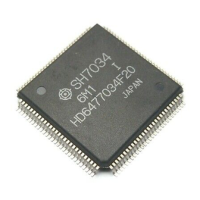58
4.3 Address Errors
4.3.1 Address Error Sources
Address errors occur during instruction fetches and data reading/writing as shown in table 4.5.
Table 4.5 Address Error Sources
Bus Cycle
Type Bus Master Operation Address Error
Instruction fetch CPU Instruction fetch from even address None (normal)
Instruction fetch from odd address Address error
Instruction fetch from outside on-chip
supporting module space
None (normal)
Instruction fetch from on-chip supporting
module space
Address error
Data read/write CPU or DMAC Access to word data from even address None (normal)
Access to word data from odd address Address error
Access to longword data aligned on
longword boundary
None (normal)
Access to longword data not aligned on
longword boundary
Address error
Access to word or byte data in on-chip
supporting module space*
None (normal)
Access to longword data in 16-bit on-
chip supporting module space*
None (normal)
Access to longword data in 8-bit on-chip
supporting module space*
Address error
Note: *See section 8, Bus State Controller (BSC), for details on the on-chip supporting module
space.
4.3.2 Address Error Exception Handling
When an address error occurs, address error exception handling starts after both the bus cycle that
caused the address error and the instructions that were being executed at that time, have been
completed. The CPU then:
1. Pushes SR onto the stack.
2. Pushes the program counter onto the stack. The PC value saved is the start address of the
instruction following the last instruction to be executed.
3. Fetches the exception handling routine start address from the exception vector table for the
address error that occurred and starts program execution from that address. The branch that
occurs here is not a delayed branch.

